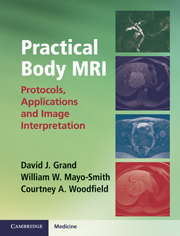Book contents
- Frontmatter
- Contents
- Preface
- To the reader
- Acknowledgments
- Glossary of terms andabbreviations used in Body MRI
- Section 1 Body MRI overview
- Section 2 Abdomen
- Section 3 Pelvis
- Chapter 7 The female pelvis: uterus
- Chapter 8 Adnexa
- Chapter 9 Female urethra
- Chapter 10 Pelvic floor / prolapse
- Chapter 11 Imaging of the pregnant patient
- Chapter 12 MRI of male pelvis
- Chapter 13 Rectal MRI
- Section 4 MRI angiography
- Index
Chapter 7 - The female pelvis: uterus
from Section 3 - Pelvis
Published online by Cambridge University Press: 05 November 2012
- Frontmatter
- Contents
- Preface
- To the reader
- Acknowledgments
- Glossary of terms andabbreviations used in Body MRI
- Section 1 Body MRI overview
- Section 2 Abdomen
- Section 3 Pelvis
- Chapter 7 The female pelvis: uterus
- Chapter 8 Adnexa
- Chapter 9 Female urethra
- Chapter 10 Pelvic floor / prolapse
- Chapter 11 Imaging of the pregnant patient
- Chapter 12 MRI of male pelvis
- Chapter 13 Rectal MRI
- Section 4 MRI angiography
- Index
Summary
Routine female pelvis protocol
Indications
The most commonly used protocol for MRI of the female pelvis. Indications include evaluation of adnexal masses, ovarian masses, fibroids, adenomyosis, endometriosis, and generalized or localized pelvic pain.
Preparation
IV contrast agent: 1 mmol/kg gadopentetate dimeglumine at 2 cc/s
Oral contrast agent: None
Have the patient void prior to the start of the study.
Start IV with at least 24-gauge needle; connect to power injector
Subtract pre-contrast images from post-contrast images
Cover from iliac crests through symphysis pubis. If pathology extends above or below these levels, increase coverage.
Exam sequences and what we are looking for
(1) Diffusion-weighted imaging b50, 500/ADC – Excellent for lesion detection.
(2) Coronal T2 single-shot fast-spin echo BH (large field of view to cover at least ½ kidneys) – Assess presence and location of kidneys. Evaluate for hydronephrosis.
(3) Sagittal T2 fast-spin echo – Evaluate uterine anatomy. Identify T2-bright and T2-dark lesions.
(4) Axial T2 fast-spin echo – Identify T2-bright and T2-dark lesions.
(5) Coronal T2 fast-spin echo FS – Identify T2-bright and T2-dark lesions. Evaluate for pelvic fluid and T2-bright osseous lesions.
(6–7) Axial T1 in and out of phase (IP/OOP) – Identify T1-bright lesions and microscopic fat.
(8) Axial volume-interpolated gradient echo BH pre – Characterize T1-bright signal in lesions.
(9) Axial volume-interpolated gradient echo BH post 70 seconds. Determine enhancement.
(10) Sagittal volume-interpolated gradient echo BH post to follow.
- Type
- Chapter
- Information
- Practical Body MRIProtocols, Applications and Image Interpretation, pp. 71 - 82Publisher: Cambridge University PressPrint publication year: 2012

